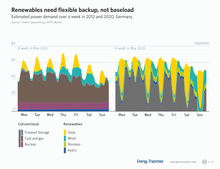
Back مولدات قابلة للتمدد Arabic Generación eléctrica despachable Spanish تولید قابل کنترل (برنامهریزی) Persian Production pilotable d'électricité French Geração elétrica despachável Portuguese

Dispatchable generation refers to sources of electricity that can be programmed on demand at the request of power grid operators, according to market needs. Dispatchable generators may adjust their power output according to an order.[1] Non-dispatchable renewable energy sources such as wind power and solar photovoltaic (PV) power cannot be controlled by operators.[2] Other types of renewable energy that are dispatchable without separate energy storage are hydroelectric, biomass, geothermal and ocean thermal energy conversion.[3]
- ^ Cooper, Duncan (22 March 2012). "Johnson's Energy Club Competes in Renewable Energy Case Competition". Samuel Curtis Johnson Graduate School of Management. Archived from the original on 16 June 2012. Retrieved 29 August 2012.
Most conventional energy sources are dispatchable, meaning that they can be turned on or off according to the demand for electricity. The amount of electricity they produce can also be turned up or down so that supply of electricity matches the amount demanded by users.
- ^ Electricity Grid: Key Terms and Definitions
- ^ Global Energy Assessment: Toward a Sustainable Future
© MMXXIII Rich X Search. We shall prevail. All rights reserved. Rich X Search